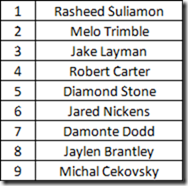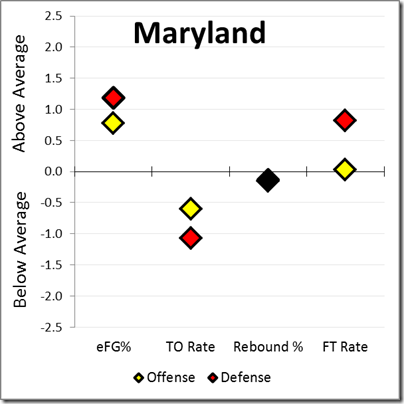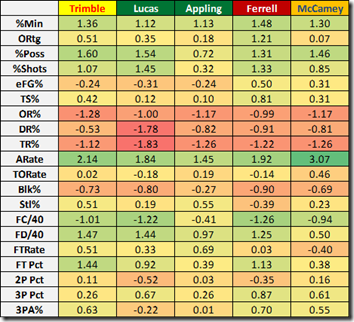2016-17 B1G Basketball Preview: Maryland

Melo Trimble [Rob Carr – Getty]
PREVIOUSLY: Illinois, Indiana, Iowa
Since joining the Big Ten for the 2014-15 season, Maryland has been one of the league’s best teams; the Terps have gone 26-10 in two years of Big Ten play and were a five- and a four-seed in trips to the NCAA Tournament – even though Mark Turgeon hadn’t had much success in his first three years in College Park, all in the ACC. Point guard Melo Trimble has been instrumental in the turnaround; even though he regressed as a sophomore, he was the leader of an impressive five-man unit: Trimble, transfers Rasheed Suliamon and Robert Carter, versatile senior Jake Layman, and 5* big man Diamond Stone.
Last year started well for UMD as they had a 21-3 record after beating Purdue in February (maybe their best win), with all three losses coming on the road – to North Carolina, Michigan, and Michigan State. They slid some towards the end of the season – in particular, an awful road loss to Minnesota may have hurt their NCAA seeding – and eventually finished 12-6 in the Big Ten, in a four-way tie for third place. They came close to upsetting Michigan State in the second round of the Big Ten tournament, but didn’t – and they beat a 13-seed and a 12-seed to make it to the Sweet 16, where they lost to Kansas, one of the best teams in the country.
There’s a nagging sense that they underachieved though. In terms of the hierarchy of the conference, they were a decidedly second-tier team; Trimble’s 3-point % and FT Rate dropped starkly; and there always the lingering feeling that the Terps’ killer five-man unit was somehow noticeably less than the sum of its parts. More than anything though, the bench offered little depth or flexibility – Trimble was the only PG and the wings couldn’t provide shooting or the minutes to go small with Carter at the five, which could have perhaps unleashed a devastating offensive lineup.
With the departures of four of the five key players for Maryland, there’s a good chance that they will take a step backwards. Trimble coming back saved them from slipping further and perhaps he will be better in a more focal role. Additionally, there’s a host of newcomers that could potentially make an impact and improve the team’s depth, but there will probably be some pretty glaring holes in the rotation. Right now, this seems like a team with a decent ceiling, though it’s fair to question how good the odds are that they approach that level.
[More on the Terps after the JUMP]
LAST SEASON
As the bubble size and usage distribution suggest, Maryland was a team that relied a lot on those five players: Trimble was the engine on offense but big men Robert Carter and Diamond Stone ate up their fair share of possessions as well. Rasheed Suliamon and Jake Layman were more complementary players on offense, both were pretty ideal 3-and-D types on the wing. In the end, each of the five had scored more than ten points per game: Trimble led the way, but with just 14.8 – down from his freshman season.
The back end is where there were some worries – none of those guys were able to do much with the ball when they were on the floor, and Turgeon couldn’t go to his bench to provide a boost or a response to an unfavorable matchup. Damonte Dodd, who will probably be getting starter minutes for the Terps at center this year, is more of a defensive anchor, so his lack of offensive production can be excused (especially because he was often surrounded by talented scorers).
The rest of the bench – guard Jared Nickens and wing Jaylen Brantley, who were effectively invisible when on the floor, as well as inefficient big Michal Cekovsky – was a big problem, and with those guys in the mix to be forced into larger contributions, there could be some issues unless they improve substantially. Somebody has to soak up the possessions vacated by the departures of Suliamon, Layman, Carter, and Stone, but there are few good candidates that were on the floor last year. Fortunately for Maryland, they have a nice influx on newcomers, though without any top recruits.
A very possible outcome is that Trimble’s usage skyrockets and he sees another tick downward in efficiency. He’s a player who’s at his best while attacking and getting to the free-throw line, and there are few players who will be able to create a shot for themselves or for others in a way that comes even close to replicating what Trimble can do. Perhaps that jump – to becoming one of the most high-usage players in the country – could make him a candidate for postseason awards (because of counting stats), but it’s hard to envision much UMD success unless a couple players exceed expectations in a big way to ease Trimble’s responsibilities.
Four Factor Z-Scores from games against Big Ten opponents
Maryland had one of the best defenses in the Big Ten last season: quite simply, opponents found it difficult to shoot from inside or outside the arc and couldn’t generate points at the free throw line. It was a conservative defense that didn’t go for steals, but it was undoubtedly effective – though it’s a little strange that they weren’t better on the glass with the amount of size they had in the frontcourt.
Their offense wasn’t quite as good, but their egalitarian scoring was good enough to be solidly efficient in a way that made up for the more relatively mediocre aspects of their offense. There was a slight tendency towards turnovers and it seems like with their size, the Terps should have been better on the offensive glass.
NEWCOMERS
Mark Turgeon signed the #2 class in the Big Ten (#12 nationally) per the 247 Composite and several of those players will be given ample opportunity to play immediately. Perhaps the best signing was a very late commitment from Canadian wing Justin Jackson: he’s a Top 100 prospect with an extremely high ceiling – Jackson doesn’t have a top notch vertical but has an insane wingspan (7’3) for a wing and could gradually develop a killer offensive game to go along with what should be an excellent defensive profile. He’s raw though, and if he’s asked to create with the ball in his hands a lot, it probably won’t go well.
Joining Jackson are two fellow Top 100 prospects who should find their way onto the floor as freshmen. Point guard Anthony Cowan is perhaps undersized, but his vision and playmaking ability will make him a natural backup to Trimble with an eye on taking on the starting role when Melo departs. Kevin Huerter is known as a great shooter with size and has displayed some combo guard tendencies; the question is if he’s strong enough to play on the wing but it might be impossible to keep him off the court if his shot translates to the college level. Those two are more highly-rated than Jackson – about twenty spots above him in the national rankings – but have much lower ceilings.
Filling out the class are wing Micah Thomas, a 3* who possesses strong all-around qualities and a great wingspan, and forward Josh Tomaic, a prospect from the Canary Islands who played at a basketball academy in Spain. Thomas could contribute right away, while Tomaic looks likely to take a redshirt.
Additional reinforcements are also on the way. Former Duquesne forward LJ Gill decided to transfer up with his fifth year of eligibility and could immediately slide into a starting role as a stretch-four type player. Gill was a low-usage player for the Dukes last season, posting shooting splits of 54 / 34 / 74 (2P% / 3P% / FT%) and not contributing much on the glass. While he’s an important addition in terms of filling out the rotation, he’s not the type of grad transfer who could make a huge impact. Maryland also gets Dion Wiley back from a season-ending knee injury – as a freshman, he was a non-descript rotation player but could be a factor on the wing in 2016-17.
PROJECTED ROTATION
-
STARTER (POINT GUARD) – Melo Trimble (Jr, 6’3, 185): Sophomore slump was fairly minor, scoring PG is still an All-American candidate, 2-point % and assist rate improvement mitigated 3-point woes and FT rate decrease.
-
STARTER (GUARD) – Dion Wiley (R-So, 6’4, 210): Torn meniscus forced him to miss last year, will probably be given first crack at the starting job, poor eFG% and turnover rate suggest this job could be up for grabs.
-
STARTER (WING) – Justin Jackson (Fr, 6’7, 225): Theoretically capable of playing 3, 4, or maybe even 5, Turgeon will probably play him mostly at the 3 and slide him down to the 4 in certain situations, potential impact player, will be better on defense than offense.
-
STARTER (WING) – LG Gill (5th-Sr, 6’8, 230): Duquesne transfer played a lot but was the least-involved starter offensively, effective inside the arc but takes half his shots from 3, played as a stretch-four at his last school and probably will again.
-
STARTER (POST) – Damonte Dodd (Sr, 6’11, 250): Played about 40% of available minutes each of the last two seasons, good shot-blocker, not much of a rebounder, and shoots a high percentage on few shots.
-
BENCH (POINT GUARD) – Anthony Cowan (Fr, 6’0, 170): True freshman was considered one of the best players in the DC area, has drawn inevitable comparisons to Trimble, perhaps more of a true distributing PG than Melo is.
-
BENCH (COMBO GUARD) – Kevin Huerter (Fr, 6’7, 190): Former Michigan target had a similar scouting profile to Nik Stauskas, but was more highly-rated by recruiting services, could work into a starting role quickly, may be a good complementary creator.
-
BENCH (WING) – Jared Nickens (Jr, 6’7, 205): Just a shooter, but only shot 35% from deep last season (down from 39% as a freshman), struggles with his shot were an underrated subplot of Maryland’s season last year.
-
BENCH (TRADITIONAL FOUR) – Ivan Bender (So, 6’9, 235): Croatian forward is pretty much an unknown at this point, his younger brother – Dragan – was drafted fourth overall in the most recent NBA Draft.
-
BENCH (POST) – Michal Cekovsky (Jr, 7’1, 250): Slovak center shot free throws poorly, turned it over a ton, posted good rebounding rates, and committed almost eight fouls per 40 minutes.
PLAYER COMPARISON
A few years ago, I came up with a system that would compare the statistical profiles of Big Ten players to their historical counterparts by taking the sum of the differences between a given player’s profile and each of the thousand player-seasons from 2008-present in twenty different statistical categories.
# value is the Z-Score of the player’s statistic (or statistics averaged over multiple seasons) relative to the entire sample
Melo Trimble is one of the best players in the conference and the names of his statistical comparables certainly corroborate that. He’s been the catalyst for Maryland for each of the past two years and his statistical profile is reminiscent of some of the Big Ten’s best point guards over the last decade or so – a junior Roy Devyn Marble and seniors Jordan Taylor and Tim Frazier are a solid top three. While Trimble falls short of the very best Big Ten point guards – for example, Trey Burke’s sophomore season doesn’t show up anywhere near the top – he’s at that next tier.
The players listed in the chart below are guys who had multiple seasons show up in Trimble’s Top 30. Kalin Lucas feels like an excellent comparison; the Spartan PG was also a floor general who was clearly running the show – and he’s much closer to Trimble’s efficiency profile than someone like Yogi Ferrell. If Ferrell is the upper limit, Keith Appling is the bottom limit – with Trimble falling somewhere in between. The big question with him is how much of his sophomore regression is going to persist into this year: if his 3-point % regresses to the mean and / or he starts getting to the free throw line with the same frequency he did as a freshman, he’ll be much closer to an All-American level player.
OUTLOOK
It would be a surprise if Maryland didn’t slide a little bit after receiving good NCAA Tournament seeds in the past two seasons. The departing players – Rasheed Suliamon, Jake Layman, Robert Carter, and Diamond Stone – are a lot for any team to withstand, but with how shallow the Terrapin bench was last season, there aren’t any players who played well in their role last season left on the team… besides Melo Trimble.
If there’s anyone in the Big Ten that could perhaps singlehandedly drag his team towards an NCAA Tournament spot, it’s Trimble. When the Maryland offense bogs down, he could put his head down and get to the rim – with a James Harden-esque herky-jerky driving style, he baits defenders into fouling him; while it’s not an enjoyable brand of basketball to watch, a guard who can seemingly get to the free throw line at will is a huge asset in college basketball. Trimble was a great shooter as a freshman (41% from three) but mediocre as a sophomore (31%) – perhaps he was leveraged into more pull-up shots as opposed to attempts set up by a driving teammate.
He’ll certainly be surrounded by new faces, most of them younger players. Anthony Cowan could perhaps allow Trimble to play a little bit off the ball, while Kevin Huerter could add playmaking on the wing in addition to his shooting ability. Justin Jackson and LG Gill will probably both be slated for big minutes at the 3 and 4, respectively; Jackson has theoretical NBA potential and Gill has more experience than most players on the Maryland roster. Things are always uncertain when newcomers are expected to make significant contributions, but talent is there.
It should be interesting to see how much success Turgeon can wring out of this roster; so much depends on Trimble, but he can’t take every shot and make every pass for this team. Some players are going to have to emerge – and the choice seems to be between talented youngsters and uninspiring veterans. Great point guard play goes a long way, but until a few players step up, it’s hard to consider this much more than a bubble team entering the season.
October 6th, 2016 at 12:50 PM ^
bubble team seems absurdly harsh for this team, thin they are more likely a 7-8 seed than anything else
October 6th, 2016 at 1:12 PM ^






Comments